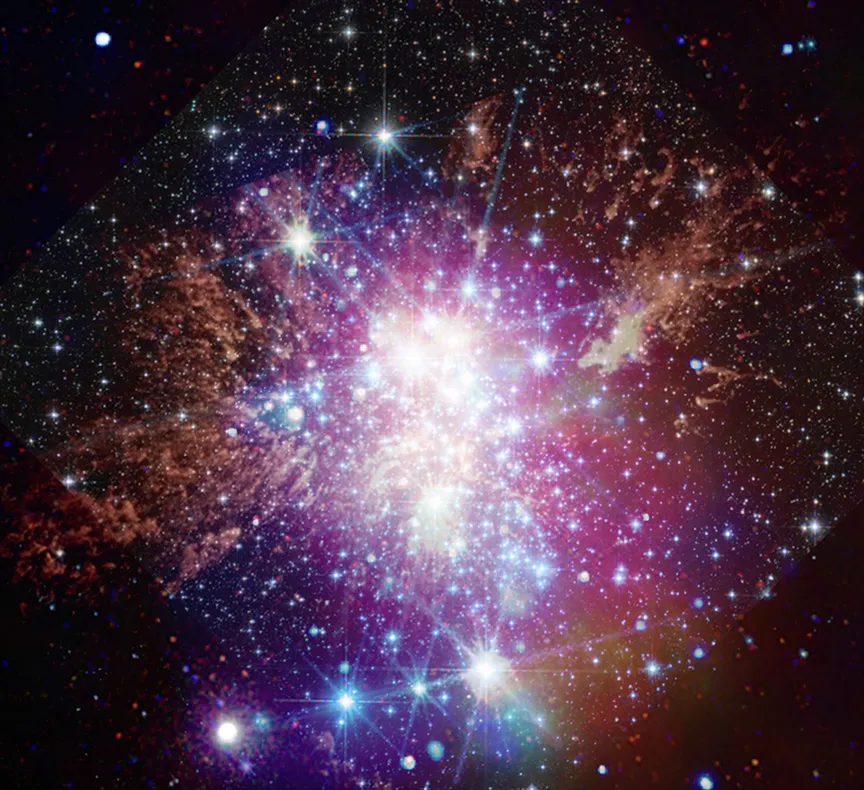Westerlund 1 Star Cluster Revealed by Chandra, Webb, and Hubble

The Westerlund 1 star cluster, the largest and closest “super” star cluster to Earth, has been unveiled in a stunning new composite image released on July 23, 2025. Located about 12,000 light‑years away in the constellation Ara, Westerlund 1 is a stellar powerhouse where massive stars are born, evolve, and die in spectacular fashion.
A Multi‑Telescope View
This latest image combines X‑ray data from NASA’s Chandra X‑ray Observatory (pink, blue, purple, orange), infrared data from the James Webb Space Telescope (yellow, gold, blue), and optical data from the Hubble Space Telescope (cyan, grey, light yellow). Together, these observations reveal the intricate structure of the Westerlund 1 star cluster in unprecedented detail.
What the Data Shows
Chandra’s X‑ray vision has detected thousands of individual stars emitting high‑energy radiation. This is a clear sign of intense stellar activity. These emissions help astronomers study the life cycles of massive stars, the effects of stellar winds, and the dynamics within dense star clusters.
Meanwhile, Webb’s infrared capabilities penetrate thick clouds of dust. As a result, it exposes stars that would otherwise remain hidden. Hubble’s optical data adds sharpness and clarity, highlighting the cluster’s complex web of gas and dust.
Why Westerlund 1 Matters
By comparing current data with past observations, scientists can track changes in the Westerlund 1 star cluster over decades. This long‑term monitoring is essential for understanding how massive stars influence their surroundings and enrich the galaxy with heavier elements. In addition, the cluster’s extreme environment makes it a valuable laboratory for testing theories of stellar evolution, supernova formation, and the role of star clusters in shaping galactic structure.
A Collaborative Effort
The image is part of a larger compilation showcasing Chandra’s work alongside other space‑ and ground‑based telescopes. Such collaborations are vital for building a complete picture of cosmic environments.
For more on NASA’s multi‑observatory projects, visit the Chandra X‑ray Observatory and James Webb Space Telescope websites.
Image credit: X‑ray: NASA/CXC/SAO; Optical: NASA/ESA/STScI; IR: NASA/ESA/CSA/STScI; Processing: NASA/CXC/SAO/L. Frattare


Well explained
Amazing writing, bro!
99excg… Simple and to the point. I like that. What are they offering though? Exchange games, yeah? Hope they’ve got a decent selection! Any thoughts gang? Right here: 99excg
Okevip, eh? Had a quick spin there. Gotta say, the selection ain’t bad. Bonuses seem kinda standard, but hey, free stuff is free stuff. My two cents right here: okevip
Taking a look at 78clb. Got potential, it seems. I will give it a try. What are your options? Go for it:78clb
Trying to get ahold of 747 Live customer service is like pulling teeth sometimes! Found some contact info on customerservice747live. Might be worth a shot if you’re stuck.
Jlace2 is a new favorite of mine. Easy to navigate and got some decent odds. Not to bad at all, give it your best shot! jlace2